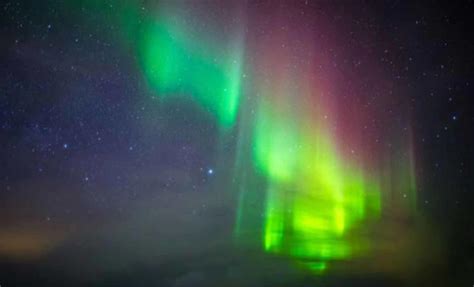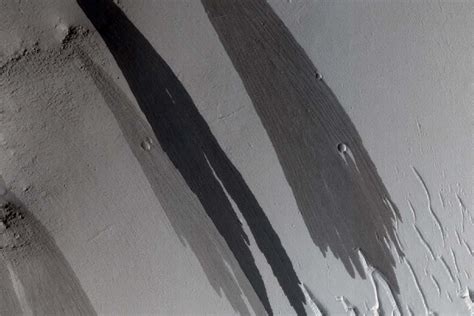
A surge of geomagnetic activity tonight could make the Northern Lights visible across an unusually wide swath of the United States, potentially reaching as far south as states like Pennsylvania, Iowa, and Oregon. Experts advise those in 24 states to be prepared for a possible dazzling display of the aurora borealis.
The aurora borealis, also known as the Northern Lights, might be visible across a large portion of the United States tonight, offering a rare spectacle for skywatchers far south of their typical range. According to the Space Weather Prediction Center (SWPC), a division of the National Oceanic and Atmospheric Administration (NOAA), a moderate geomagnetic storm is in progress, increasing the likelihood of seeing the aurora in states not normally associated with the phenomenon.
“A moderate G2 geomagnetic watch is in effect,” the SWPC stated, signaling that the conditions are ripe for enhanced auroral activity. This geomagnetic storm is the result of a coronal mass ejection (CME) from the sun, which has sent charged particles hurtling towards Earth. When these particles interact with the Earth’s magnetic field and atmosphere, they excite atmospheric gases, causing them to glow and produce the mesmerizing colors of the aurora.
The 24 states where the Northern Lights might be visible include: Washington, Idaho, Montana, North Dakota, South Dakota, Wyoming, Minnesota, Wisconsin, Michigan, Iowa, Illinois, Indiana, Ohio, Pennsylvania, New York, Maine, Vermont, New Hampshire, Massachusetts, Rhode Island, Connecticut, Oregon, Colorado, and Nebraska.
While the visibility of the aurora is never guaranteed, especially in more southern locations, experts recommend taking certain steps to maximize your chances of witnessing the display. The most important factor is finding a dark location away from city lights. Light pollution can significantly obscure the faint glow of the aurora, making it difficult or impossible to see.
“Find a dark spot away from city lights,” advises space weather experts. “The darker the sky, the better your chances of seeing the aurora.”
Another helpful tip is to check the real-time aurora forecasts provided by the SWPC. These forecasts provide up-to-the-minute information on the intensity and location of the aurora, helping you determine whether conditions are favorable in your area. Several websites and apps also offer aurora alerts, notifying you when the lights are likely to be visible.
The colors of the aurora can vary depending on the type of gas that is being excited in the atmosphere. The most common color is green, which is produced by oxygen at lower altitudes. Higher altitudes can produce red auroras, while nitrogen can create blue or purple hues. The intensity and vibrancy of the colors can also vary depending on the strength of the geomagnetic storm.
Even if you are not able to see the aurora with your naked eye, you may still be able to capture it with a camera. Digital cameras are much more sensitive to light than the human eye, and they can often pick up the faint glow of the aurora even when it is not visible to the naked eye. To photograph the aurora, use a wide-angle lens, a high ISO setting, and a long exposure time.
The occurrence of the Northern Lights is not only a beautiful spectacle but also a reminder of the dynamic relationship between the Earth and the sun. Geomagnetic storms can have a variety of effects on our planet, including disrupting radio communications, interfering with satellite operations, and even causing power outages. Scientists study these storms to better understand the space weather environment and to develop ways to mitigate their potential impacts.
This particular geomagnetic storm is classified as a G2, which is considered moderate. G1 storms are minor, while G5 storms are extreme and can cause widespread disruptions. While a G2 storm is not likely to cause major problems, it is still important to be aware of its potential effects.
For those living in areas where the aurora is rarely seen, this event presents a unique opportunity to witness one of nature’s most stunning displays. Even if the aurora is not visible to the naked eye, the increased geomagnetic activity can still create beautiful sunsets and sunrises. The interaction of charged particles with the atmosphere can scatter sunlight, producing vibrant colors in the sky.
Whether you are a seasoned aurora chaser or a first-time viewer, this event is a reminder of the beauty and power of nature. The Northern Lights are a testament to the complex processes that shape our planet and its environment. By taking the time to observe and appreciate these phenomena, we can gain a deeper understanding of the world around us.
FAQ: Northern Lights Potential Viewing Tonight
1. What are the Northern Lights (Aurora Borealis)?
The Northern Lights, also known as the Aurora Borealis, are a natural light display in the sky, predominantly seen in the high-latitude (Arctic and Antarctic) regions. Auroras are produced when the magnetosphere is sufficiently disturbed by the solar wind that the trajectories of charged particles in both solar wind and magnetospheric plasma, mainly in the form of electrons and protons, precipitate them from space into the upper atmosphere (thermosphere/exosphere). These particles ionize and excite atmospheric constituents, which subsequently emit light of varying color and complexity. The colors typically range from green, pink, red, yellow, blue, and violet.
2. What causes the Aurora Borealis?
The aurora is caused by charged particles, mainly electrons and protons, entering the atmosphere from space, causing ionization and excitation of atmospheric constituents, and consequent optical emissions. Most of these particles originate from the sun and travel to Earth on the solar wind. The solar wind carries with it the sun’s magnetic field. When this field meets the Earth’s magnetic field, a complex interaction occurs that shunts the charged particles into the Earth’s magnetosphere. These particles then follow the Earth’s magnetic field lines towards the poles, where they interact with the atmosphere, causing the aurora. Coronal Mass Ejections (CMEs) and high-speed solar wind streams can significantly enhance auroral activity by delivering more charged particles to the Earth’s magnetosphere.
3. Which areas are most likely to see the Northern Lights tonight?
According to the Space Weather Prediction Center (SWPC), the following 24 states have an increased likelihood of seeing the Northern Lights: Washington, Idaho, Montana, North Dakota, South Dakota, Wyoming, Minnesota, Wisconsin, Michigan, Iowa, Illinois, Indiana, Ohio, Pennsylvania, New York, Maine, Vermont, New Hampshire, Massachusetts, Rhode Island, Connecticut, Oregon, Colorado, and Nebraska. The farther north you are within these states, the better your chances of seeing the aurora. However, even those in the southern parts of these states might have a chance, depending on the intensity of the geomagnetic storm.
4. How can I improve my chances of seeing the Northern Lights?
To maximize your chances of seeing the Northern Lights:
- Find a dark location: Get away from city lights and other sources of light pollution. The darker the sky, the more visible the aurora will be.
- Check the aurora forecast: Monitor the real-time aurora forecasts provided by the SWPC and other space weather websites. These forecasts will give you an idea of the intensity and location of the aurora.
- Look north: The Northern Lights typically appear in the northern sky.
- Be patient: It may take some time for the aurora to become visible. Be prepared to wait and watch the sky for a while.
- Use a camera: Even if you can’t see the aurora with your naked eye, a digital camera may be able to pick it up. Use a wide-angle lens, a high ISO setting, and a long exposure time.
5. What is a geomagnetic storm, and how does it affect the Aurora?
A geomagnetic storm is a temporary disturbance of the Earth’s magnetosphere caused by solar activity, such as coronal mass ejections (CMEs) and high-speed solar wind streams. These events send a surge of charged particles toward Earth, which interacts with our planet’s magnetic field. The strength of a geomagnetic storm is measured on a scale from G1 (minor) to G5 (extreme). A stronger geomagnetic storm means more charged particles are interacting with the atmosphere, leading to a more intense and widespread auroral display. The current geomagnetic storm is classified as a G2 (moderate), which is strong enough to potentially make the Northern Lights visible in areas much farther south than usual.
Expanded Article:
The ethereal dance of the Northern Lights, a spectacle typically reserved for the high-latitude regions of the globe, may grace the skies of 24 U.S. states tonight. Thanks to an anticipated surge in geomagnetic activity, residents as far south as Pennsylvania, Iowa, and Oregon have a chance to witness the aurora borealis, a phenomenon born from the interaction of solar winds and Earth’s magnetic field.
The Space Weather Prediction Center (SWPC), a division of the National Oceanic and Atmospheric Administration (NOAA), has issued a “moderate G2 geomagnetic watch,” indicating conditions are ripe for enhanced auroral displays. This heightened activity stems from a coronal mass ejection (CME), a colossal expulsion of plasma and magnetic field from the sun’s corona. When a CME reaches Earth, it compresses the magnetosphere, accelerates charged particles, and injects energy into the ionosphere, thus triggering geomagnetic storms.
The states potentially within the viewing range include Washington, Idaho, Montana, North Dakota, South Dakota, Wyoming, Minnesota, Wisconsin, Michigan, Iowa, Illinois, Indiana, Ohio, Pennsylvania, New York, Maine, Vermont, New Hampshire, Massachusetts, Rhode Island, Connecticut, Oregon, Colorado, and Nebraska. While visibility remains contingent on local weather conditions and the storm’s intensity, experts advise those within these regions to seek dark skies, away from the pervasive glow of urban light pollution, to maximize their chances of witnessing the aurora.
“Find a dark spot away from city lights,” experts emphasize. “The darker the sky, the better your chances of seeing the aurora.” This simple yet crucial advice underscores the impact of artificial illumination on astronomical observations. Light pollution scatters atmospheric particles, creating a diffuse background glow that obscures fainter celestial objects, including the aurora.
For those unfamiliar with the aurora, it is a natural light display in the sky, predominantly seen in the high-latitude (Arctic and Antarctic) regions. Auroras are produced when the magnetosphere is sufficiently disturbed by the solar wind that the trajectories of charged particles in both solar wind and magnetospheric plasma, mainly in the form of electrons and protons, precipitate them from space into the upper atmosphere (thermosphere/exosphere). These particles ionize and excite atmospheric constituents, which subsequently emit light of varying color and complexity.
The colors of the aurora are a direct consequence of the atmospheric gases being excited by the incoming charged particles. Oxygen, the most abundant gas in the lower atmosphere, emits green light when struck by electrons at lower altitudes (around 60 miles) and red light at higher altitudes (above 200 miles). Nitrogen, another prevalent gas, produces blue or purple hues. The intensity and dominance of each color depend on the energy of the incoming particles and the density of the atmosphere at different altitudes.
The SWPC’s real-time aurora forecasts provide invaluable insights into the auroral activity. These forecasts are based on a combination of ground-based magnetometer readings, satellite observations of the solar wind, and sophisticated computer models that simulate the interaction between the sun and Earth. By monitoring these data streams, scientists can predict the intensity, location, and timing of auroral displays.
Moreover, various websites and mobile applications offer aurora alerts, notifying users when conditions are favorable for viewing the lights. These alerts typically rely on the same data sources as the SWPC forecasts but present the information in a user-friendly format. Some apps even incorporate augmented reality features, overlaying a virtual aurora onto a live camera feed, allowing users to visualize the potential display in their local sky.
Capturing the aurora with a camera has become increasingly popular, thanks to the sensitivity of modern digital sensors. Even when the aurora is too faint to be seen with the naked eye, a camera can often reveal its subtle glow. To photograph the aurora, a wide-angle lens is essential to capture a broad expanse of the sky. A high ISO setting (e.g., 1600 or 3200) increases the sensor’s sensitivity to light, allowing for shorter exposure times. Long exposure times (e.g., 5-30 seconds) are necessary to gather enough light to create a visible image. A sturdy tripod is crucial to prevent camera shake during long exposures.
Beyond its aesthetic appeal, the aurora is a window into the complex dynamics of the Earth’s magnetosphere and its interaction with the sun. Geomagnetic storms, which trigger auroral displays, can also have significant impacts on technological infrastructure.
Strong geomagnetic storms can disrupt radio communications, particularly high-frequency (HF) radio used by aviation, maritime, and emergency services. The increased ionization in the ionosphere can absorb or scatter radio waves, reducing their range and reliability. Satellite operations can also be affected by geomagnetic storms. Charged particles can damage satellite electronics, degrade solar panel performance, and disrupt communication links. Operators often take precautionary measures, such as temporarily shutting down sensitive instruments or adjusting satellite orbits, to mitigate these risks.
In extreme cases, geomagnetic storms can even cause power outages. The fluctuating magnetic fields generated by the storm can induce currents in long conductors, such as power lines. These induced currents can overload transformers and other electrical equipment, leading to widespread blackouts. The most notable example of this occurred in March 1989, when a powerful geomagnetic storm caused a major power outage in Quebec, Canada, affecting millions of people.
Scientists are actively studying geomagnetic storms to better understand their underlying mechanisms and to develop more accurate forecasting models. This research involves a combination of space-based observations, ground-based measurements, and sophisticated computer simulations. By improving our understanding of space weather, we can better protect our technological infrastructure and mitigate the potential impacts of geomagnetic storms.
The current geomagnetic storm, classified as G2, is considered moderate. G1 storms are minor and typically cause only weak auroral displays and minor fluctuations in power grids. G3 storms are strong and can cause intermittent satellite navigation problems and HF radio disruptions. G4 storms are severe and can cause widespread voltage control problems in power grids and prolonged radio blackouts. G5 storms are extreme and can cause complete collapse of power grids and satellite failures.
While a G2 storm is unlikely to cause widespread disruptions, it is still important to be aware of its potential effects. Power grid operators monitor geomagnetic activity closely and take steps to mitigate any potential risks. Satellite operators may adjust satellite orbits or shut down sensitive instruments. Radio operators may switch to alternative frequencies or communication methods.
For those living in areas where the aurora is rarely seen, this event presents a unique opportunity to witness one of nature’s most stunning displays. The aurora is a reminder of the power and beauty of the natural world. It is a testament to the complex interactions between the sun, the Earth, and the atmosphere.
Even if the aurora is not visible to the naked eye, the increased geomagnetic activity can still create beautiful sunsets and sunrises. The interaction of charged particles with the atmosphere can scatter sunlight, producing vibrant colors in the sky. These colors can range from deep reds and oranges to bright pinks and purples.
Whether you are a seasoned aurora chaser or a first-time viewer, this event is an opportunity to appreciate the wonders of the universe. By taking the time to observe and learn about the aurora, we can gain a deeper understanding of our place in the cosmos.
The aurora borealis is not just a visual spectacle; it is a manifestation of fundamental physical processes that govern the space environment around Earth. It connects us to the sun, our star, and reminds us of the dynamic forces that shape our planet. The possibility of witnessing this extraordinary event, even in regions where it is rarely seen, is a gift from nature, urging us to look up, to wonder, and to appreciate the beauty of the universe. The potential for viewing the Northern Lights highlights not only a unique celestial event but also underscores the importance of scientific research and space weather monitoring in our increasingly technological world. As we look towards the sky tonight, we are reminded of the intricate dance between Earth and the sun, a dance that produces moments of breathtaking beauty and profound scientific significance. Understanding these phenomena enhances our appreciation for the complexities of our planet and its place in the vastness of space. Therefore, the anticipation surrounding tonight’s aurora viewing opportunity serves as a reminder of the importance of continued exploration and discovery in the field of space science.
The SWPC continuously monitors solar activity and provides forecasts of space weather conditions. These forecasts are essential for protecting our technological infrastructure and ensuring the safety of astronauts in space. By supporting space weather research and monitoring, we can better prepare for and mitigate the potential impacts of geomagnetic storms.
In conclusion, the potential visibility of the Northern Lights across an unusually wide swath of the United States tonight presents a rare opportunity to witness one of nature’s most spectacular displays. While visibility remains contingent on local weather conditions and the storm’s intensity, those in the 24-state viewing range are encouraged to seek dark skies and monitor the aurora forecasts. This event serves as a reminder of the dynamic relationship between the Earth and the sun and the importance of space weather research and monitoring. It’s a chance to connect with the natural world and appreciate the beauty and power of the universe.








